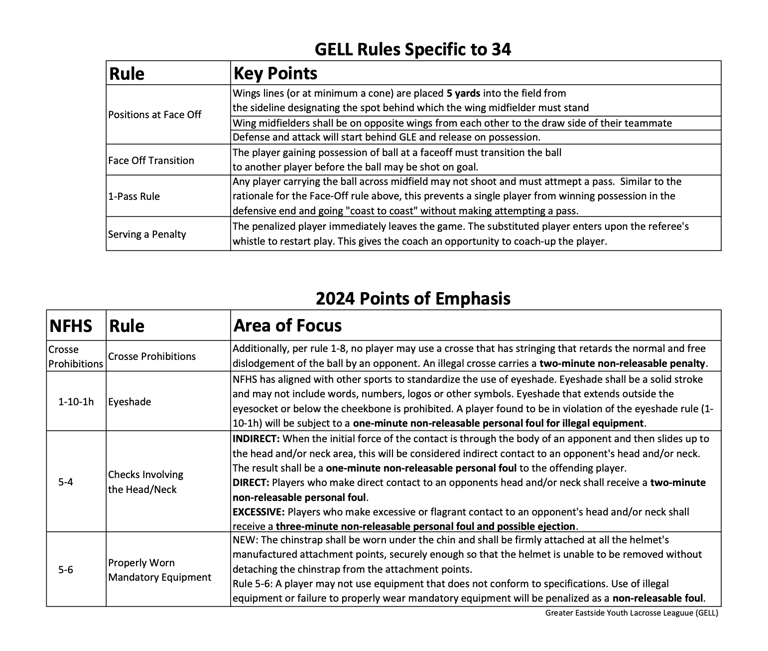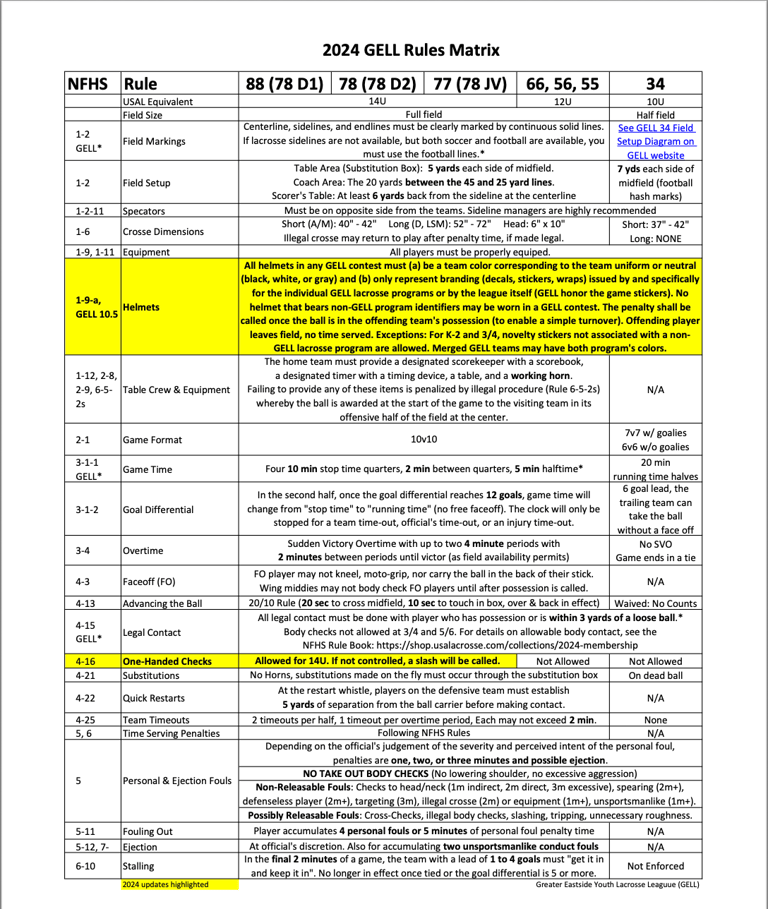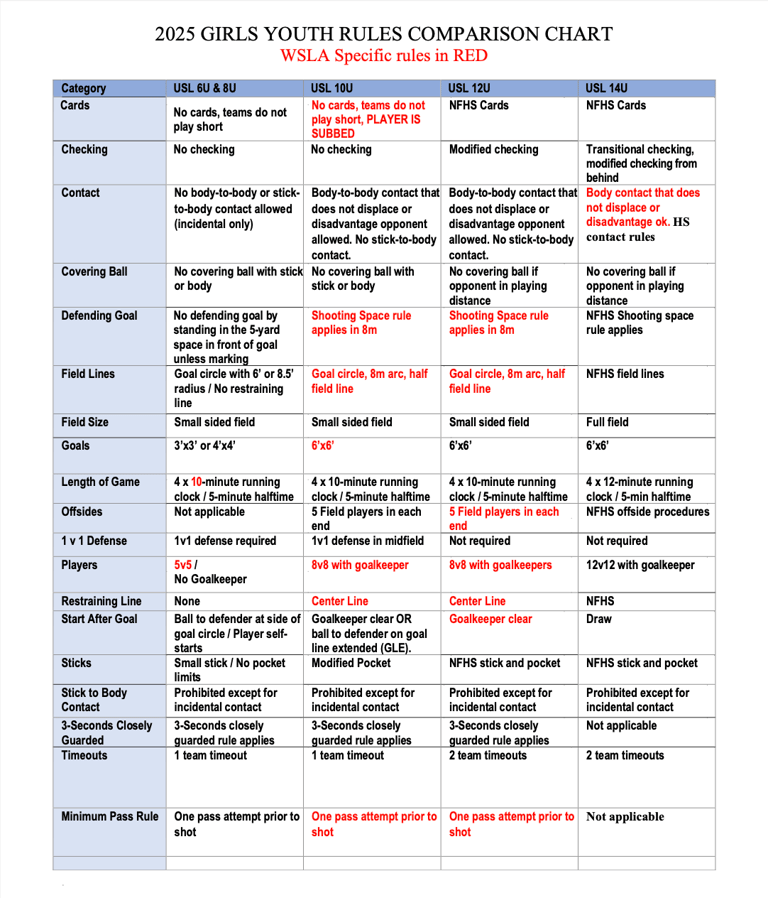Also known as the fastest game on two feet, lacrosse is a fast-paced team sport played on a field about the size of a football field. Opposing teams of 10 or 12 players try to score points by using a 3 ft long stick with a mesh basket on the end of it to scoop, pass, catch, cradle, dodge, and shoot a small rubber ball into a 6 ft x 6 ft goal.
Boys lacrosse and girls lacrosse share the same origins, use similar skills, and have the same objectives but are fairly different from one another. Boys lacrosse is a fast and physical contact sport and as such, players wear substantial padding. Girls lacrosse is non-contact and full of finesse and quick movements. The design of boys and girls sticks are different, the field size and markings are different, and number of players on the field also differs.
Keep reading to learn about the history of lacrosse. We also have a section below on the rules and gameplay for both girls and boys. However the best ways to learn about lacrosse is to (1) pick up a stick and play and (2) watch a game
The Creator's Game
History of Lacrosse
The modern game
Lacrosse is the oldest team sport in North America. It originated over 900 years ago with the Haudenosaunee peoples, the Mohawk, Oneida, Onondaga, Cayuga, Seneca, and Tuscarora tribes, in what is now upstate New York and southern Ontario. The original games were played with hundreds of participants across fields that could be miles long and lasted from sun up to sun down or even several days. It is often known as the 'Creator's Game' or the 'Medicine Game' because it's not just a sport, but also a ceremonial practice used for healing, community building, training warriors, settling disputes among tribes, and honoring and entertaining the Creator. Lacrosse still holds deep meaning and significance in the lives of the Haudenosaunee and other native groups today.
Implicit in these origins is the idea that we honor the game. That means we play our hardest and remain humble no matter the outcome, we treat our teammates and our opponents with respect, and we remember that it is a privilege to be able to play this great game. Please watch the following two videos on lacrosse's historical and mythological origins and also note how lacrosse is a game for everyone - no matter who you are as a person, and whether you are swift like a deer, strong like a bear, have the vision of a hawk, or have a heart like the squirrel, you belong.
The history of lacrosse
The story of the first lacrosse game
The first Europeans to encounter lacrosse were French Jesuit missionaries in the St. Lawrence Valley in the 1630s, some 500 years after the Haudenosaunee invented the game. The missionaries called the game la crosse because the stick resembled a bishop's crossier.
The modern version of lacrosse took shape when a Canadian dentist, Dr. William George Beers, founded the Montreal Lacrosse Club in 1856 and in the 1860s drew up rules that included reducing the number of players, and introducing a rubber ball and a redesigned stick.
Lacrosse soon became Canada’s national summer game and in 1867, exhibition games were played in England. Queen Victoria watched a game being played and remarked that the game was “very pretty to watch.” In 1883 or 1884, a touring team from Canada and a Haudenosaunee team visited Scotland. The first headmistress at the St Leonard's school in Scotland watched that game and thought it “beautiful and graceful.” As a result, the game was introduced at the school, thus originating the women's game.
Rosabelle Sinclair, an alumnus of St Leonard's and a former Scottish lacrosse player, was instrumental in establishing the game of lacrosse for women in the United States. She started a girls’ high school team in 1926 at Bryn Mawr School in Baltimore, Maryland and soon after lacrosse became popular in other nearby schools. The U.S. Women’s Lacrosse Association was formed in 1931.
By the 20th century, many high schools, colleges and universities had adopted lacrosse as a league sport. Lacrosse became an Olympic sport for the 1904 and 1908 Summer Olympics, but was then dropped as an official sport. It will be returning for the 2028 Los Angeles Olympics.
Rules and game-play for boys lacrosse
This video does a great job of explaining how boys lacrosse is played




Rules and game-play for girls lacrosse
Women's lacrosse is played by 12 players per team: one goalkeeper, four attackers, three midfielders (including 1 draw), and four defenders. At the youth level there may be fewer players depending on age. The object of the game is to shoot the ball into the opponent's goal. The team scoring the most goals wins.
Women's lacrosse begins with a draw, which is taken by the center position. The ball is placed between two horizontally held crosses (sticks) at the center of the field. At the sound of the whistle, the ball is flung into the air as the crosses are pulled up and away. A draw is used to start each half and after each goal, and it takes place at the center of the field.
A field is 120 yards by 70 yards, though depending on age, youth teams may play on modified fields. Markings on the field include a center circle where the draw takes place, a midfield line, restraining lines located 30 yards from each goal line, which creates an area where only a maximum of seven offensive players and eight defensive players (including the goalkeeper) are allowed; a 12-meter fan, which officials use to position players after fouls, and an 8 meter arc in front of each goal, considered the critical scoring area, where defenders must be at least within a stick's-length of their attacker. At the youth level the center line may be used as the restrainng line depending on age.
Positions
Attackers: The attackers line up in their attacking half of the field. These players are typically the team’s goal scorers. Their role is to get into scoring positions around the goal, take shots, and score goals.
Midfielders: The midfielders are the team’s primary ball carriers, control the pace of the game, and play both offense and defense. If you love running, midfield might be a good match for you.
Defenders: Defenders remain in the defensive half of the field and their primary goal is to create turnovers and prevent the other team from getting close to the goal or taking shots.
Goalie: Finally, there is the goalie, who stands in the crease. The goalie is the only player that is able to touch the ball with her hands, but she may only do so while inside the crease. Once the goalie gets control of the ball she has ten seconds to either pass the ball to a teammate or to run it out of the crease herself.
Basic Rules
Pushing, tripping, hitting an opponent with your stick, etc is not permitted
Shooting Space and Dangerous shots: Some of the most confusing rules concern when shots can be taken and defended. Since girls aren't wearing pads and helmets it is important that players avoid shooting the ball into another player, likewise it is important that a defender not step into the path of a shot. When inside the 8-meter arc that surrounds the goal, offensive players must move to establish free space to shoot, known as "shooting space." This is a lane that an offensive player will take to shoot. If a defender jumps into this lane, obstructing the offensive player as they prepare to shoot, the defender will be penalized for a shooting space violation. Conversely, a dangerous shot is an offensive foul that occurs when an offensive player takes a shot when a defender is already in position, resulting in a dangerous play.
3 second Rule: A defensive player is penalized for being inside the 8-meter arc longer than 3 seconds without marking a player on the opposing team. Any defensive player inside the 8-meter arc must be guarding another player, they can't just be hanging out in the middle of the arc alone.
Offside and the Restraining Lines: When looking a girl's lacrosse field from above, you will notice there are two lines that run across the field and split it into thirds. These are known as the restraining lines and they help determine when a team is on or offside. Each team, while allowed 11 field players on the field, is only allowed to have 7 of those players in the offensive and defensive ends. This means that while the play is going on at one end of the field, 4 field players must hold behind the restraining line nearest to where the play is occurring. This rule allows teams to have space offensively and defensively. It would be very crowded if all 11 field players played at both ends of the field.
Stick checks: Stick checking is allowed. Stick checks must be swift, clean, and contact must only be between the be heads of the sticks, only when the opposing player has the ball, and the checking stick must be further than 12 inches from the opposing girl’s head or neck, which is why a close cradle is essential. Cradling is when a player moves their wrists and arms in a semi-circular motion to keep the ball in the pocket of the stick's head using centripetal force.
8-meter shots: An 8-meter shot is a free-position shot awarded to an offensive player after a major foul by a defender within the 8-meter arc, or "hash marks," in front of the goal. All other players, except the goalie, are cleared out of the 8-meter area to create a scoring opportunity, similar to a free throw in basketball or penalty kick in soccer. The offensive player positions themselves on a hash mark and must be defended only by the goalie, with the player who committed the foul positioned at least 4 meters behind the shooter.


Watch a lacrosse game
High school games
2025 3A Boys High School Championship
Bellevue vs Mercer Island
2025 Girls Varsity High Championship
Seattle Prep vs Mercer Island
College games
2025 NCAA Men's Championship
2025 NCAA Women's Championship
Contact
General questions and registration:
registrar_at_shorelinelacrosse.org
Boys program director and high school head coach
mattsoko_at_shorelinelacrosse.org
Girls program director and high school head coach
Equipment related questions:
© 2025 Lake Forest Park Shoreline Lacrosse Club. All rights reserved.

